CONSTELLATION GUIDE
Last updated: 3 July 2001
CONSTELLATION GUIDE |
"GO TO"....PISCES
....there's something really fishy about this part of the sky....
From: sherrodc@ipa.net (Clay Sherrod)
This is the 21st Constellation Guide, "GO TO PISCES" of the series "GO TO GUIDES for the ETX and LX 90 Telescope Users". This constellation is a bit different than many others - and largely ignored - because of its huge size, few bright stars, no naked eye benchmarks, and a very limited offering of deep sky objects. it covers an enormous chunk of the southern skies, suitable for observers in both hemispheres and spans from 23 hours to over 2 hours in right ascension and incredibly from + 35 degrees to -05 degrees in declination. Yet within this entire constellation there is NOT ONE galactic cluster, globular, planetary nor diffuse nebula to be found with amateur instruments.
Of galaxies, there are a total of 18 brighter than 14th magnitude, but only EIGHT (8) suitable for amateur observations and all but ONE of those are limited strictly to the ETX 125 and larger telescopes! Thus....there is only ONE true "deep sky object" that can be found with moderate amateur telescopes in all of PISCES!
Now do you understand why this large constellation is largely ignored - other that by "astrologers?"
Now, by "deep sky object" I am referring to non-stellar objects and never include the remarkable double and multiple stars that might be seen. This is one category in which Pisces rules. It has no less than 81 fine multiple stars, the majority of which can be detected with some range of amateur instruments. Of these 81 multiple stars, many are the brightest stars in Pisces, including Alpha itself!
Thus, in addition to a somewhat abbreviated description of the "viewable" galaxies in Pisces with this "GO TO" TOUR, we will explore many of these brighter multiple stars and some which are challenging and, simply, beautiful!
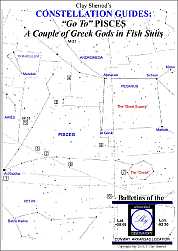
Pisces (pronounced "PIE-seez") is just ONE of seven constellations in this region that has some association with "water," and reveals the fascination of water subjects (perhaps due to arid conditions of the "original" Arabian namers of the stars?) to the earliest stargazers. In addition to the "aquatic" fish, we have the Water Bearer of AQUARIUS, CETUS (a whale), PISCES AUSTRINUS (southern fish), CAPRICORN (the "seat goat"), DELPHINUS (the dolphin), and ERIDANUS (a celestial river). The importance of seafaring to the earliest people and the need for good navigational targets such as stars provide close to the southern horizons, likely gave rise to this "watery association."
A familiar, yet rather faint "asterism" (conspicuous outline or pattern of stars within a constellation) is the CIRCLET of stars which comprise the "western fish" of Pisces. The Circlet is shown in our star chart for Pisces and is comprised of the stars: Gamma, Kappa, Lambda, Iota, Theta, 19 Piscium and 7 Piscium. note that 19 Piscium is discussed as a variable star in our list of "GO TO" object below.
You will note that many of the southern constellations (the far south constellation of ARGO - a "ship" - is truly representative of this) were so referred due to the earliest outreaches of civilizations as they explored the vast southern passageways around the world, using the then-unknown southern stars as their benchmarks for celestial navigation. Since so many of the bright southern star groups were NOT named nor recognized, the sailors merely began referring to them by aquatic and navigational names (i.e, "SEXTANS" the sextant) which carried over to astronomers back home who subsequently "assigned" the constellations. (see http://www.weasner.com/etx/ref_guides/lacerta.html for a brief discussion on how our currently-accepted 88 official constellations came to be!).
Pisces is ALSO fairly unique for such a large constellation in that it has NO star brighter than nearly magnitude 4.0....indeed, "Alrisha", the alpha star (in the Bayer designation of the Greek alphabet) is only "scraping" to be a bit brighter at magnitude 3.94!
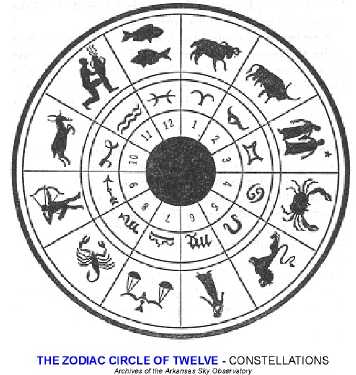
Astrologically and to the earliest Arabian stargazers, Pisces the Fish was the LAST of the twelve "houses of animals"....the Zodiac (see old woodcarving above). You will note in our star chart that the Celestial Equator (0 degrees declination) passes almost nearly midway north-south through Pisces and thus objects in this constellation can have either positive or negative declinations. In addition, note that the ECLIPTIC in which the sun, moon and planets appear to move relative to Earth also passes from due east into Pisces and crosses out of the southwest corner. Thus, it is not uncommon for the planets and more frequently the moon to be located in this large constellations for extended periods of time.
Of all the constellation legends, Pisces perhaps has one of the most interesting history. In the earliest Greek mythology, the constellation represents TWO fish....one of them is a disguised goddess VENUS while the other is none-other than the love-providing CUPID. Neither, of course, were "fish" in Greek mythology but were forced in legend to assume the fish identity to escape a deadly monster - TYPHON - who had brought havoc to the Olympic gods. The great god Zeus had rallied the Olympians to defeat their arch enemies the "Titans" who were the sons of the evil goddess Gaea. As revenge, Gaea conceived another son, Typhon, who was reared on evil and taught destruction and evil ways which he used with supposed supernatural powers and strength to slowly and methodically reduce the power of the Olympians.
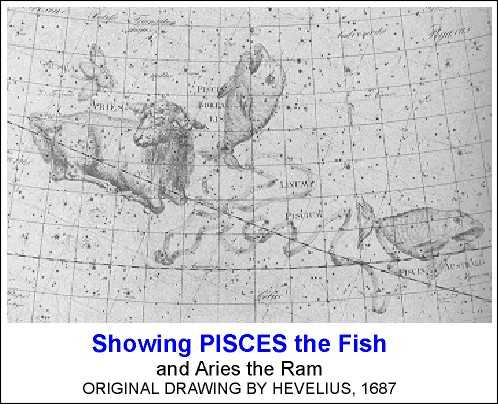
To escape, many of the "more important" ("....women and children first!") Olympians learned that if they assumed the characteristics of animals, they would escape notice and destruction by the evil Typhon. Thus, the chosen mode of disguise for Venus and Cupid was....fish - a seemingly odd association with the goddess and the heralder of love....In the beautiful drawing by Hevelius shown above you can clearly see the two fish (can anyone tell which is Venus and which is Cupid?) as well as the "cord" [ see Object 1 below ] that attaches tethers the two.
.....perhaps this is where the term "cold as a fish" originated?
As with all "GO TO" TOUR guide star charts, please click on this accompanying chart above to open; you can save this to file, resize to paper size and print for a nice usable desk reference or good field chart as you proceed through the Pisces "GO TO" TOUR.
Also with every "GO TO" TOUR guide, each GO TO object in Pisces is discussed for your telescope regarding the type of conditions necessary for you to view it optimally for discern the very faintest details.........magnifications and aperture necessary for most objects, and much, much more. This is YOUR complete GUIDE to get you on your way to exploring the best (and few!) objects in these two constellations. The following listing of "BEST" objects contains the finest or most interesting from my own observing experience and preference.
Use the star chart and the following Guide as an excellent reference for your next star party itinerary, or a beginning for further study into the thousands of objects visible in this part of the sky. Truly these extensive Constellation Study Guides will most definitely put your AutoStar to work for you in the most efficient and enjoyable way possible! As a matter of fact, MANY AutoStar users are now programming their own "Tours" based on these guides, using each constellation as a separate GO TO Tour for the AutoStar library that can be added in or deleted through the main edit screen on your PC or MAC computer.
We hope you enjoy these comprehensive GUIDES to touring the constellations via your AutoStar and its computer-driven telescope. Each new installment is complete with diagrams, charts and illustrations that you will find nowhere else. Please let us hear YOUR feedback and your observations of each and every constellation after YOU have toured its vast reaches of our skies!
-----------------------------------
YOUR PISCES CONCISE DIRECTORY OF INTERESTING OBJECTS -
I have chosen the finest (or most interesting) 12 objects in this PISCES "GO TO" TOUR; as with all GUIDES, all objects listed below will be visible in most telescopes (some naked eye) from the ETX 60 through the LX 90; of course larger apertures may "show" an object a bit closer and "better," but frequently a wide field and low power view is more desirable than aperture for FINDING the objects initially. Indeed, I strongly encourage you first FIND the target object, or its approximate location through your GO TO function with your lowest power and then - once IDENTIFIED positively - move up slowly in steps with magnification if necessary. Remember, not all objects "like" magnification. Sometimes better "field of view" (such as the wonderful wide fields provided by the ETX 60 and 70) is desired over light gathering (like the big LX 90) and magnification.
The rule for determining "optimum magnification" is that: 1) too low power results in sky background glow detracting or diminishing the contrast against the deep sky object; 2) too high magnification darkens BOTH the sky background AND the object; 3) medium magnification can be achieved at which you have MAXIMUM contrast between the object and its darkened background sky. I have found through three decades of direct observing that about 15x per inch aperture (36x for the ETX 60/70; 55x for the ETX 90; 75x for the ETX 125; and, 125x for the LX 90).for deep sky observing is PERFECT for most objects. That being said, always remember that DOUBLE or multiple stars require whatever power you can crank out....the seeing conditions are the limiting factor here.
For my complete and comprehensive discussion regarding seeing conditions and sky transparency, see: http://www.weasner.com/etx/buyer-newuser-tips/seeing.html .
With all deep sky objects, avoid attempting to observe when the moon is in the sky, even a very thin crescent, as its brightness in the sky will overshadow the very dim contrast afforded by even the brightest deep sky object; if you see the object at all against moonlight, you will NOT see the subtle outlying areas or the full detail of what is presented.
Pisces is dominant in late summer skies; riding mid-way on the Celestial Equator, it is suited for long-period observing for ETX and LX 90 users both north and south of the equator. The "Circlet" in western Pisces rises in the east about dark (9 p.m. local time) on about July 25 and the center of the constellation "culminates " (passes over the meridian at midnight) around October 3, remaining in the sky throughout that night. All deep sky objects and difficult double stars are ALWAYS best observed when they are located nearly overhead (or as high in the sky as possible), thus requiring the observer to look through the thinnest portion of the Earth's "lens" of atmosphere and haze.
As with all of the "GO TO" TOUR constellation lists, I recommend a good star atlas and/or chart which will list all the finest objects, constellation-by-constellation. One very handy reference guide is the PETERSON FIELD GUIDE TO THE STARS AND PLANETS, which features complete lists with declinations, right ascensions, magnitudes, and all pertinent information for you to expand your observing horizons beyond this brief GUIDE.
Note that your AutoStar will NOT have every object listed on every constellation GO TO tour....this is intentional. You can access some of the most interesting objects of the sky directly from their coordinates. It is quite simple as you merely enter these coordinates as follows in the 10-step process:
1) Press the "MODE" key and hold down for 3 seconds and release; 2) Displayed will be the current Right Ascension and Declination of the center of field of view of where your telescope is presently pointed (assuming that you have properly aligned from "home position"); 3) [NOTE: if you have the Meade electric focuser attached to any of the ETX or LX telescopes, holding down the "MODE" key will bring up the "Focus" command first....merely scroll (lower right scroll key) down one step to access the RA and DEC to enter your desired coordinates] 4) Press the "GO TO" button on AutoStar; 5) This will change the display and you will note the cursor blinking over the first digit of RIGHT ASCENSION (R.A.); merely use the number keys and dial in the R.A. of the object you are searching for; 6) When done, press "Enter;" 7) This moves the blinking cursor over the "DEC" coordinates; 8) [NOTE: the declination, unlike R.A., can be either positive or negative and you will see the "+" or "-" sign displayed depending on where your telescope is aimed at that time; if it is NOT the desired setting (plus or minus), merely use your arrow key to move the blinking cursor OVER the "+" or "-" sign and change by using either of your lower corner SCROLL KEYS; 9) Proceed to enter the DEC using number keys; 10) Press either "Enter" or "Go To" when finished and the telescope begins slewing to your desired object!!
The constellation tour Star Chart above (click on and save to a file on your PC; then open it and re-size to fit the page and print for a very handy at-the-scope star chart) will get you started on your journey for this constellation.
Following is the concise object list for your "GO TO" TOUR of PISCES; you may wish to find the majority of the objects from the AutoStar Library (for example, you can easily go to the galaxy Messier 74 if you pull up "Object/Deep Sky/Messier/..then type in '74'...." and then press "Enter", followed by "GO TO" to access this "only" lonely galaxy in Pisces. On the other hand, if you want to experiment and become a "better AutoStar user" try entering the exact R.A. and DEC coordinates of that object as described above after holding down the MODE key. You will find the accuracy of entered GO TO's to be somewhat less than those stored in AutoStar, but the capability of acquiring unlisted objects is fantastic!
OBJECT 1:
brighter star/nice double star - Al Rischa - Alpha Piscium - R.A. 01h 50' / DEC +02 31 - Mags: 4 & 5
OBJECT 2:
good double star - Zeta Piscium - R.A. 01h 11' / DEC + 07 19 - Mags. 5.5 & 6.4 - good in all scopes!
OBJECT 3:
great double - Psi Piscium - R.A. 01h 03' / DEC + 21 12 - Mags: 5.5 & 5.8 - good low power double!
OBJECT 4:
good double for ETX 90 - 65 Pisc - R.A. 00h 47' / DEC + 27 26 - Mags. 6.3 & 6.3 - 4.4" arc split!
OBJECT 5:
tough double for '90 - ADS 1254 - R.A. 01h 33' / DEC + 07 23 - Mag: 7.6 & 7.6 - A tough 1.6" arc!
OBJECT 6:
your challenge double - 27 Pisc. - R.A. 23h 56' / DEC (-) 03 50 - Mags. 5.0 & 10.8 - tough for ETX 125
OBJECT 7:
nice variable for all scopes/binoculars - TX Pisc - R.A. 23h 44' / DEC +03 13 - Range 6.8 - 8 - nice!
OBJECT 8:
"Van Maanen's Star" - R.A. 00h 47' / DEC + 05 09 - Mag. 12.4 (!) - An unusual white dwarf. ETX 125 +
OBJECT 9:
doubled star test for LX 90 - ADS 287 - R.A. 00h 18' / DEC + 10 42 - Mags: 6.9 & 7.8 - only 0.6" split!
OBJECTs 10:
nice galaxy - Messier 74 (ngc628) - R.A. 01h 34' / DEC + 15 32 - Mag. 10.1 - very large spiral
OBJECTs 11 through 17:
faint galaxies but brighter than visual 12.6
NGC GALAXIES PISCES(other than those listed above)
listing of "ngc" galaxies in Pisces in order of RIGHT ASCENSION (and NGC # order)
NOTE: These NGC galaxies may NOT be detailed in the following "Visual Guide"
as are those Objects 1-10 listed above...use the abbreviated descriptions as they follow the order:
NGC# / R.A. / DEC / MAGNITUDE / SIZE (in minutes arc -'-) / GALAXY TYPE , description
ngc0470 / 01 17 / +03 09 / 12.4 / 1.7 x 1.1 - spiral, very faint an tilted; can be seen in ETX 125
ngc0488 / 01 19 / +05 00 / 11.0 / 4.2 x 3.3 - pretty and large spiral, fairly bright....very round, concentrated
ngc0514 / 01 23 / +12 39 / 12.3 / 2.7 x 2.7 - face-on spiral, very faint; ETX 125 and up; fairly small
ngc0520 / 01 22 / +03 32 / 12.4 / 3.0 x 0.7 - very narrow and faint, LX-90 only; irregular/peculiar galaxy
ngc0524 / 01 22 / +09 16 / 11.6 / 1.8 x 1.7 - tiny elliptical; starlike, can be seen in ETX 90 but barely
ngc0718 / 01 51 / +03 57 / 12.5 / 1.2 x 1.0 - very small, faint spiral, object for LX 90 only
ngc7619 / 23 18 / +07 55 / 12.4 / 1.0 x 1.9 - tiny elliptical galaxy, starlike in ETX 125 and LX 90
....SO LET'S SWIM WITH THE FISHES IN THE CELESTIAL SEA and "sea" what comes up!! (refer to the Pisces Star Chart for all the objects described in detail on the "Guide")
---------------------------------
A VISUAL GUIDE TO OUR DEEP SKY OBJECTS IN PISCES [NOTE: since so many double stars are recommended in this tour, please refer to the LAST installment "GO TO" Lacerta for details on proper determinations of position angles for double stars. Since most of these included with the Pisces guide are relatively easy and spectacular doubles, most are referred to casually by "direction" rather than "position angle." Nonetheless, practice finding these via Position Angle (P.A.) to become a better student of astronomy]
Object 1 - Our "Starting" Brighter Star - "AL RISCHA" (alpha Piscium) This is not only our starting "alpha" star for Pisces but a very nice double star right now. Its name comes from the Arabic Al Risha, which denotes "the cord", or fishing line that is connecting the two "fish" Venus and Cupid in their clever disguises! Moving in a very slow orbit of 720 years, the two stars are about as close now as it will be until the year 2085 when the two stars will be only 0.7" arc apart from our viewing post here on Earth. Presently the separation is just over 1.0" arc and MIGHT be split in the ETX 90 under extremely steady skies and high power (about 200x). The primary star is magnitude 4.3 and is companion is slightly fainter at magnitude 5.2 almost exactly SW from the brighter star (Position Angle 235 degrees). Look for a nice color contrast on these two stars, yet no two observers seem to see the SAME colors....some see "green and white," while others may record them as "green and blue." This is an easy star to find, but the splitting of it might take the ETX 125 and medium-high powers. Don't miss this nice double star!
Object 2 - Zeta Piscium - A Wonderful, Colorful Double Star for the ETX 60 and Above - LOW POWER! This is a wonderful double star for low power and wide field observing, with an incredible color contrast of a light purple (fainter star) and pure white. At magnitudes 4.2 and 5.3 this is an easy and beautiful double for the ETX 60 all the way up to the LX 90....separation is a full 24" arc! Thus, low power and wide field afford a beautiful view of this relatively bright star immersed in a nice field of stars. However, to view the nice color contrast, use medium powers, or about 15x per inch aperture. Anything high or lower will lose the beauty of this star!
Object 3 - A Great Double Star - Psi Piscium - Great Low Power Double No one gets left out of this constellation guide! Here is another gorgeous double star, both stars yellow in color and pretty bright and equal in magnitudes (5.5 & 5.8). The separation of these two stars is about 30" arc, or slightly smaller than Jupiter might appear in the same eyepiece. Look for the "fainter" star nearly due south of the brighter primary one. Low powers are ideal for this pretty star.
Object 4 - Another Double - 65 Piscium - a Really Nice Star Pair, and a TEST for the ETX 70! Although this star is a MUST for all telescopes, here is a rather "rare" double star test for the ETX 60 and 70. This is a gorgeous star - both stars exactly magnitude 6.3(!) so they are visible in very low powers and even in most finderscopes. Two twin stars are separated by 4.4" arc, easily resolvable in the ETX 90 and larger scopes (this is a pretty sight....so you guys and girls with larger telescopes do NOT ignore this one!). However, it is not so easy with the wide field refractors ETX 60/70, requiring some magnification (I suggest the most you can muster). Look for the stars oriented in a near east-west (Position Angle 269 degrees). In the ETX 90 and larger scopes I recommend about 20x per inch for the best views.
Object 5 - A Super Test Object for the ETX 90 - Double Star ADS 1254 This will be a challenge - but a fun one! - for the ETX 90; at separation 1.6" arc in position angle 50 degrees (almost exactly NE -SW orientation) here is a pair of EXACT equal brightness (magnitude 7.6) stars that are easy to find in all scopes....however, anything less than 3" aperture will not resolve this pair and the ETX 90 should split this cleanly. Use pretty high magnification (at least 125x) for the best views in all scopes. The star will be quite faint in the 8 x 25 finders of the ETX scopes and fairly so in the LX 90's 8 x 50 ...nonetheless, in the telescope at low "finding power" this star will be among the brightest in a wide field view. This is a VERY nice double (yellow, sun-like stars) in ALL scopes 3" and larger. A good double.
Object 6 - 27 Pisc - WHAT??!! Another double star? Yep, and it get really tough here..can you handle it? Okay ETX 90 users....you did a good job on ADS 1254 above. Feeling pretty good? How about you ETX 125 owners? Piece of cake? Well....let's try this one. At a closer 1.5" arc separation you would think that 27 Piscium would be just about as easy as ADS 1254, but hold on. The primary star here is a bright magnitude 5.1 (the brightest object in your low power field) but the secondary - at Position Angle 276 degrees, nearly DUE WEST - is only magnitude 10.8, make it a very tough star for the ETX 90...but "still" attainable. Give it a shot. You have the resolving power (the ETX 90 is rated at a separation "power" of 1.3" arc) and the light grasp (you should be able to see a star as faint as magnitude 11.7) so TRY it! Even the ETX 125 might have some difficulty on this star with the proximity of the brighter star masking out the faint companion. Use the finder chart (I have drawn to match the "mirrored" orientation of the ETX, LX and all compound scopes) to actually locate this star.
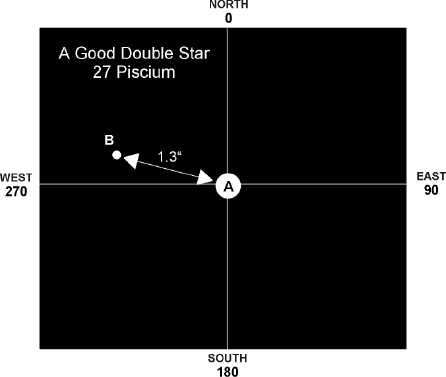
Object 7 - Variable Star - 19 Piscium - Also TS PSC for Variable Star Observers You can find this star by downloading the fine comparison chart from the American Association of Variable Stars (AAVSO) web site; the one here is the "b" low power chart which will be ample for both finding the star in your finderscope (or binoculars) AND measuring its brightness relative to nearby stars provided on the chart. This is a good binocular variable, but still can be monitored in a wide field low power eyepiece. To obtain the chart, click on and save to file the link charts.aavso.org/STANDARD/PSC/TX_PSC/TXPSC-AB.GIF and open, resize to page and print out for use at the telescope. TS PSC varies in magnitude from 5.3 to 6.2 which is NOT much, but this is a very interesting variable from a scientific standpoint. First, it has no set period and changes can be seen visual within a short span of fractions of a day; Second, this star varies differently in different colors of light! This can be seen even visually using both a blue and a red filter on the eyepiece. In addition, there will be very long periods in which the star will remain unchanged, only to begin suddenly fluctuating in minor amounts. Because of the unpredictable nature and infrequent changes of this star, I recommend giving it a quick look at every opportunity and reporting your magnitude estimates to the AAVSO at www.aavso.org about once a month.
LESSON NOTE: this is a very red star and there is a special technique necessary for estimating the magnitude of a RED STAR. All observers, when looking at a very red object for any length of time, will notice that the object will "appear" to get brighter the more it is observed. This is called the "Perkinje Effect" and is totally due to the eye's ability to accumulate and store wavelengths of light in the red end of the spectrum. Hence the more you look at 19 Piscium or even Mars for that matter, the brighter it will appear over time! To offset this effect when estimating magnitudes, the "trick" here is to DEFOCUS your red star from a point source (the Airy Disk) to a larger "extended" disk of light and compare the out-of-focus "donut" (small, mind you, not too large) to the out-of-focus images of nearby comparison stars!
To get an idea of JUST HOW RED this star really is...compare it to the blue stars nearby 21 and 25 Piscium!
Object 8 - A White Dwarf and Very Unusual Star - "Van Maanen's Star" - ETX 125 and LX 90 Only - Faint! The best way of locating this star is by looking about 2 degrees south of Delta Piscium and using the reversed star chart (for use with catadioptic telescopes) that I have specially prepared from the Smithsonian Astrophysical Observatory Star Catalog Charts. The limiting magnitude of this chart is about 14 and Delta Piscium is just outside the LOWER part of the view here....the circle is one degree in total diameter,north at top and EAST is to the right, just as it would be in your scope. The circle itself is "about" the field of view (slightly wider) in the ETX 125 and LX 90 with a 32mm eyepiece, and the "bright" star see to the lower right of Van Maanen's Star is magnitude 6.7, barely visible in the finder of our telescopes.
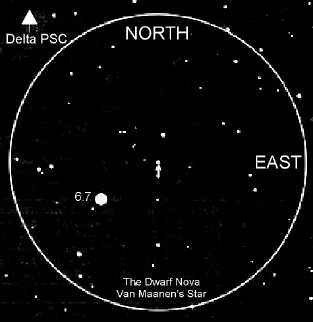
Now, about "Van Maanen's Star in particular. It obviously was discovered by a gentleman named Mr. Van Maanen, in 1917 to be specific; he noted the star particularly because of its large annual PROPER MOTION, or its rapid movement across the sky relative to more distant fixed stars; thus, he deduced that this must be very close star....so close that it actually progresses SE each year by almost 3" arc! Indeed, it has now been found that it is rivaled only by the companion to the bright star Sirius as the closes white dwarf to Earth. The remarkable fact of this star is its diameter - IT IS ACTUALLY SMALLER than the Earth, at only 7,680 miles across! HOWEVER - it is so dense that ONE CUBIC INCH of this star would weigh an incredible 20 TONS!
The star visually is magnitude 12.4, thereby "possibly" barely visible in the ETX 90, but certainly so in the ETX 125 and larger scopes. The brighter star in the chart above is equally interesting as it TOO appears to be moving in the SAME DIRECTION as the faint star, but only a bit slower and about twice the distance from us. This is a must-see if your telescope can handle a 12th magnitude white dwarf that weighs 20 tons for each inch of its mass!
Object 9 - ADS 287 - A Very Close Double Star for the LX 90 Also known as Barnard 1093 this is a nice - but very close - double star, with a clear yellow-orange cast to both stars. At separation only 0.6", it will be a challenge to cleanly split these two 6.9 and 7.8 magnitude stars with the big 8" scope. Look for the fainter star in position angle 100 degrees, or just south of due east from the brighter star. About 300x will be required to separate the two components and over 400x will be better should the atmosphere be "steady" enough to handle that kind of magnification.
Object 10 - Actually a Deep Sky Object!! - Messier 74, a Fine Spiral Galaxy! In this huge constellation this is the ONLY deep sky object of merit, and certainly the only one suitable for modest amateur telescopes. At Magnitude 10.1, this galaxy appears actually a bit brighter and is certainly visible in the ETX 60 as a very large circular glow, 11' arc across!
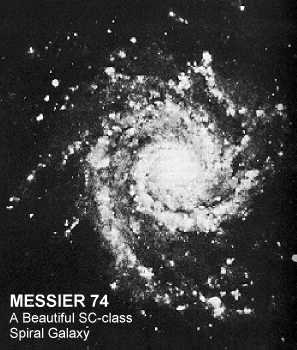
The photograph above taken through the famous Palomar 200" reflector shows the incredibly symmetrical and circular shape of this face-on galaxy. Notice how tightly the very "rough" arms are wound into the broad "hub" of this galaxy. Hence, the spiral arms are visible in any moderate to large amateur telescopes and visible as very non-uniform "clumped" appendages due to the beautiful and dense star groups which can plainly be seen in this photograph. Although this galaxy appears very large in our telescopes, it is an incredible 30 million light years away!
Regarding viewing conditions, always use LOW POWER and a wide field of view to best observer this galaxy....the light of it is so spread out over such a large area that very wide fields (and smaller telescopes!) actually reveal much more detail that high powered views.
--------------------------------
WANDERING ABOUT....YOUR NEW "USER OBJECT" IN PISCES
We have to make Van Maanen's Dwarf Nova our GO TO USER OBJECT for Pisces (we do because I understand there is a law and they DO enforce it where Mr. Maanen is from...). This is likely the ONLY dwarf novae that you will actually be able to not only view for yourself, but also share with others at star parties and special events. Because of its proximity to the bright star Sirius, that white dwarf companion is a much more difficult object (see: http://www.weasner.com/etx/ref_guides/sirius.html ). Thus, this white dwarf star is an ideal "show and tell" object for the ETX 90 and larger telescopes at ANY star party.
I highly recommend reading up on this fascinating breed of stars it Robert Jastrow's "Red Giants and White Dwarf" so that you will be well versed in the unusual nature of these stars and their evolutionary tracts.
On AutoStar, go to: "Select/Object [enter]...." scroll down to "User Object" [ enter]. Now enter the coordinates given above for "Van Maanen's Star", using the number keys on AutoStar. After entering the coordinates and pressing "Enter" yet again, scroll down one and you can list the magnitude of the object as "12"[Enter].
So with the addition of a white dwarf star, you have a growing User Object library which includes a black hole, dark nebulae, curious multiple stars, variable stars and even more weird deep sky objects. All of these are wonderful for conversation-starters and crowd-stoppers at the big astronomical events!
Next Constellation GO TO" TOUR Installment: ANDROMEDA. Because of the wonderful Messier 31 galaxy and a few other very special objects, requests for a GO TO guide for this constellation have been outranked ONLY by those wanting loads of exciting explorations of Orion and Taurus! So in a couple of weeks we will visit the wonder world of the Andromeda galaxy and other worlds beyond.
Good Observing and explorations of this wonderful world of deep space!
P. Clay Sherrod
Arkansas Sky Observatory
Conway / Petit Jean Mountain
Arkansas
Return to the top of this page.
Go back to the Observational Guides & References page.
Go back to my ETX Home Page.